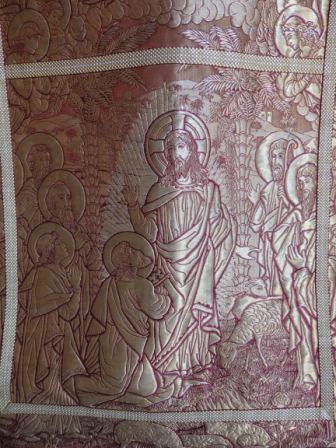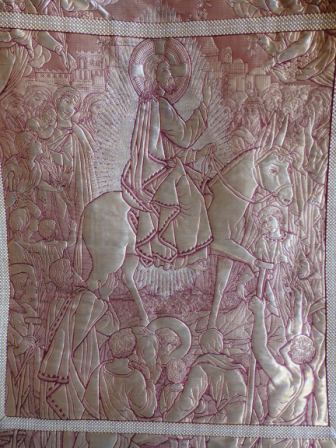21 November
Conferences
OUR HERITAGE, OUR bequestTESTIMONY OF TRADITIONS AND BELIEFS
Our wealth of heritage: liturgical vestments
Ms. Alicia Andueza Pérez
PhD in Art History
As part of the work of dissemination of the monumental and artistic heritage carried out by the Chair de Patrimonio y Arte Navarro, this lecture focused on the textile heritage, in relation to a set of garments of French origin that are preserved in the parish of Pitillas and that arrived there by the hand of Bishop José Cadena y Eleta, a native of this town.

José Cadena y Eleta, born in Pitillas, became bishop of Segovia, Vitoria and Burgos.
Antique textiles are an important part of the decorative arts that until recently have not received much attention. In recent years, several programs of study have come to light that highlight the importance of this subject of pieces and the need to value them, since the passage of time, the fragility of the material itself and in many cases, inadequate conservation, have caused that much has been lost. Within the textile heritage, the one that has reached our days the most is the one related to liturgical vestments, since their use was not habitual and daily as it could happen with civilian clothing. In addition, the Church has done an outstanding job in the custody of this subject of garments, since it considered them sacred. Even so, if we take into account the historical news about the pieces that constituted the textile trousseaus of the Navarrese parishes in the past, very little has survived.
Once the topic was contextualized, the first part of the lecture analyzed the main sacred ornaments from a double point of view: from their liturgical function, paying attention to their origin, symbolism and color; and, on the other hand, from their form, that is to say, as vehicles of artistic expression through which the styles of each era are manifested. Likewise, their catechetical and pedagogical function was emphasized, since many of these garments bore scenes or passages from the life of Jesus, the Virgin or the Saints.
As for the ensemble preserved in the parish of San Pedro de Pitillas, we examined the issues related to its origin and technical, artistic and iconographic characteristics. Its singular French origin was highlighted, since it is a series of garments that were made in Lyon, specifically in the workshop of Joseph-Alphonse Henry. This artisan made this set, between 1889 and 1900, according to designs by the painter Gaspard Poncet. The different garments that compose it are called "angélique" because the iconographic motif that is repeated in all of them is that of angels. This robe is composed of a rich fabric called lampás and is completely decorated with different historical passages that extol the role of Jesus as Master and Savior. Its richness led to the production of numerous copies of this subject of pieces, some of which are preserved in several French churches and cathedrals. In the case of the Pitillas terno, it arrived at the parish in 1907 as a gift from Don José Cadena y Eleta, former bishop of Segovia, Vitoria and Burgos, who carried out an important work of promotion of the arts in his native town.


Details of the chasuble, made in Lyon between 1889 and 1900 by Joseph-Alphonse Henry, following the designs of painter Gaspard Poncet.
by Joseph-Alphonse Henry, following the designs of the painter Gaspard Poncet.
To conclude, the artistic value of the set was highlighted, since despite being garments made in series on a mechanical loom, they are of great quality. In addition, its testimonial value was highlighted, since they are part of the heritage and identity of an entire people and because they are sample, in turn, of a different way of understanding the liturgy and sacred worship.
